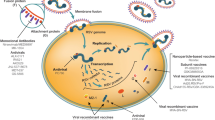Abstract
Palivizumab (Synagis; Abbott Laboratories), a humanized, monoclonal antibody, prevents lower respiratory tract infection by respiratory syncytial virus (RSV). RSV causes significant morbidity and mortality in young children worldwide and is particularly severe in pre-term infants, children with cardiopulmonary disease, and the immunosuppressed population. The first such genetically engineered agent to be used effectively against a human infectious disease, palivizumab significantly reduces the number of hospitalizations caused by RSV in high-risk infants. This article reviews the preclinical development and clinical experience of palivizumab.
Similar content being viewed by others
References
Garenne M, Ronsmans C, Campbell H. The magnitude of mortality from acute upper respiratory infections in children under 5 years in developing countries. World Health Statist Q 1992;45:180–91.
Glezen WP, Taber LH, Frank AL, Kasel JA. Risk of primary infection and reinfection with respiratory syncytial virus. Am J Dis Child 1986;140:543–6.
Kapikian AZ, Mitchell RH, Chanock RM, Shvedoff RA, Stewart CE. An epidemiology study of altered clinical reactivity to respiratory syncytial (RS) virus infection in children previously vaccinated with an inactivated RSV virus vaccine. Am J Epidemiol 1969;89:405–21.
Simoes EAF, Sondheimer H, Top FH Jr, Meissner HC, Welliver RC, Kramer AA, et al. Respiratory syncytial virus immune globulin for prophylaxis against respiratory syncytial virus disease in infants and children with congenital heart disease. J Pediatr 1998;133:492–9.
Takeuchi Y. Epidemiological and clinical features of influenza and respiratory syncytial virus infections among children in Japan. Acta Paediatr Jpn 1988;30:231–9.
Saijo M, Ishii T, Kokubo M, Takimoto M, Takahashi Y. Respiratory syncytial virus infection in lower respiratory tract and asthma attack in hospitalized children in North Hokkaido, Japan. Acta Paediatr Jpn 1993;35:233–7.
Saijo M, Takahashi S, Kokubo M, Saino T, In-Yaku F, Ishii T, et al. The role of respiratory syncytial virus in acute bronchiolitis in small children in northern Japan. Acta Paediatr Jpn 1994;36:371–4.
Sigurs N, Bjarnason R, Sigurbergsson F, Kjellman B. Respiratory syncytial virus bronchiolitis in infancy is an important risk factor for asthma and allergy at age 7. Am J Respir Crit Care Med 2000;161:1501–7.
Young J. Development of a potent respiratory syncytial virus-specific monoclonal antibody for the prevention of serious lower respiratory tract disease in infants. Respir Med 2002;96(Suppl B): S31–5.
Johnson S, Oliver C, Prince GA, Hemming VG, Pfarr Ds, Wang SC, et al. Development of a humanized monoclonal antibody (MED-493) with potent in vitro and in vivo activity against respiratory syncytial virus. J Infect Dis 1997;176:1215–24.
The IMpact-RSV Study Group. Palivizumab, a humanized respiratory syncytial virus monoclonal antibody, reduces hospitalization from respiratory syncytial virus infection in high-risk infants. Pediatrics 1998;102:531–7.
Groothuis JR, Nishida H. Prevention of respiratory syncytial virus infections in high-risk infants by monoclonal antibody (palivizumab). Pediatr Int 2002;44:235–41.
Simoes EAF, Groothuis JR. Respiratory synctytial virus prophylaxis. The story so far. Respir Med 2002;96(Suppl B):S16–25.
Groothuis JR, Simoes EAF, Levin MJ, Hall CB, Long CE, Rodriguez WJ, et al. Prophylactic administration of respiratory syncytial virus immune globulin to high-risk infants and young children. N Engl J Med 1993;329:1524–30.
The PREVENT Study Group. Reduction of respiratory syncytial virus hospitalization among premature infants with bronchopulmonary dysplasia using respiratory syncytial virus immune globulin prophylaxis. Pediatrics 1997;99:93–9.
Stevens TP, Sinkin RA, Hall CB, Maniscalco WM, McConnochie KM. Respiratory syncytial virus and premature infants born at 32 weeks’ gestation or earlier: hospitalization and economic implications of prophylaxis. Arch Pediatr Adolesc Med 2000;154:55–61.
Greenough A, Cox S, Alexander J, Lenney W, Turnbull F, Burgess S, et al. Health care utilisation of infants with chronic lung disease, related to hospitalisation for RSV infection. Arch Dis Child 2001;85:463–8.
Sorrentino M, Powers T, and the Palivizumab Outcomes Study Group. Effectiveness of palivizumab: evaluation of outcomes from the 1998 to 1999 respiratory syncytial virus season. Pediatr Infect Dis J 2000;19:1068–71.
Cohen AH, Sorrentino M, Powers T. Effectiveness of palivizumab for preventing serious RSV disease. J Respir Dis 2002;2(Suppl): S30–2.
Oh PI, Lanctôt KL, Yoon A, Lee DSC, Paes BA, Simmons BS, et al. Prophylaxis for respiratory syncytial virus in Canada: outcomes and utilization with palivizumab during the 1999–2000 season. Pediatr Infect Dis J 2002;21:512–8.
van Kan CI, Eenhoorn PC, Zweens MJ, Woltil HA, Baarsma R. Palivizumab surveillance: an evaluation of RSV-related hospitalization of high-risk children after palivizumab prophylaxis in The Netherlands during the 1999–2000 RSV season. Abstract presented at Fifth World Congress of Perinatal Medicine, 23–27 September 2001, Barcelona, Spain.
Lacaze-Masmonteil T, Rozé J-C, Fauroux B, and the French pediatricians group of the Synagis patients’ name based program. Incidence of respiratory syncytial virus-related hospitalizations in high-risk children: follow-up of a palivizumab-prophylaxed cohort. Pediatr Pulmonol 2002 in press.
Hand I, Boron M, Van Veldhuisen P, for the Synagis Outcomes Registry. Synagis (palivizumab) prophylaxis of respiratory syncytial virus (RSV) infection. Patient demographics and preliminary results from the 2000–2001 Synagis Outcomes Registry. Poster for Abstract #1714, presented at the Fifth World Congress of Prerinatal Medicine, 23–27 September 2001, Barcelona, Spain.
Carbonell-Estrany X, Quero J, Bustos G, Cotero A, Domenech E, Figueras-Aloy J, et al. Rehospitalization because of respiratory syncytial virus infection in premature infants younger than 33 weeks of gestation: a prospective study. Pediatr Infect Dis J 2000;19:592–7.
Carbonell-Estrany X, Quero J, and the IRIS Study Group. RSV hospitalization rates in premature infants born over two consecutive seasons. Pediatr Infect Dis J 2001:20:874–9.
Grässl G, Andreou A, Pinquier D, Maragliano G, Lagercrantz H, Guimaraes H, et al. Efficacy and safety of palivizumab (Synagis) in preterm infants 29–32 weeks gestational age without chronic lung disease to prevent serious respiratory syncytial virus respiratory tract infection. Abstract presented at the Fifth World Congress of Perinatal Medicine, 23–27 September 2001, Barcelona, Spain.
Author information
Authors and Affiliations
Corresponding author
About this article
Cite this article
Pollack, P., Groothuis, J.R. & Barbarotto, G.M. Development and use of palivizumab (Synagis): a passive immunoprophylactic agent for RSV. J Infect Chemother 8, 201–206 (2002). https://doi.org/10.1007/s10156-002-0178-6
Received:
Published:
Issue Date:
DOI: https://doi.org/10.1007/s10156-002-0178-6




